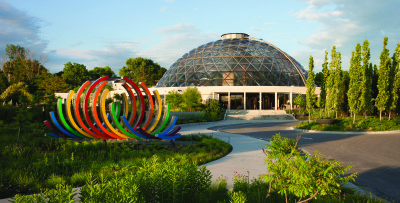
The Greater Des Moines Botanical Garden is located at 909 Robert D. Ray Drive in Des Moines. Call (515) 323-6290 or visit www.dmbotanicalgarden.com for a schedule of events and programs. Photos courtesy of the Greater Des Moines Botanical Garden
By John Busbee
The Greater Des Moines Botanical Garden evokes a bounty of soothing descriptives whenever its name is mentioned. Tranquility. Oasis. Reflection. It also is home to a diverse and expanded footprint as one of Iowa’s most unique cultural experiences. Nurtured under its distinctive geodesic dome is a myriad of tropical and exotic foliage, whisking visitors on botanical journeys to far corners of the world. Recently, its Master Plan achieved its next phase, opening seven acres of outdoor gardens, presenting a river front vista of majestic proportions.
If there ever was a case for a variation of the saying, “It takes a village…,” this would be the case for today’s Greater Des Moines Botanical Garden. Not just a village, but a stewardship that arcs over several generations, beginning with a desire to create a “horticultural facility for the benefit of the citizens of Des Moines and Central Iowa.”
Initial efforts almost a century ago were led by the Des Moines Garden Club and the Des Moines Founders Garden Club, and supported through the Des Moines City Council and the Park Board, according to news in the Des Moines Register & Tribune in 1929. Original plans were to establish in Greenwood Park a Floral Park and a signature Floral Conservatory Building, surrounded by formal gardens, a Rose Garden and aquatic plants in a lake.
One especially noteworthy luminary involved with this project was Jay N. “Ding” Darling, the noted conservationist and Pulitzer Prize-winning political cartoonist for the Des Moines Register. Darling suggested including a two-story structure at Greenwood Pond, with a warming house for ice skaters on the lower level and a garden center housed in the upper floor.
However, the $25,000 needed to complete the project was not available, as the Great Depression caused many development plans to be shelved. Nonetheless, parts of the original plan were implemented and one notable space remains today — The Rose Garden in Greenwood Park. With designs by Harold Parnham and Amos Emory, The Rose Garden is a crown jewel in the Des Moines park systems network of green spaces.
As the Great Depression was coming to an end, Eliel Saarinen presented a plan for the design of an art center on the site for the original floral conservatory. The plan was approved in 1945 and the new Des Moines Art Center opened in 1948. Darling and other members of the Men’s Garden Club wanted to incorporate a portion of this new building for a public garden center, but the new Art Center decided it needed that space for a gift shop and rental gallery. When Saarinen presented his art center plans, the city’s original conservatory in Union Park was 40 years old and in need of replacement. The City of Des Moines purchased a bankrupt commercial greenhouse on Second Avenue, eventually adding three more greenhouses, as a temporary site for the city greenhouse until a more suitable structure could be built.
In a 1955 resolution, the Horticulture Committee of the Park Board directed the Parks Superintendent to gather information on construction of a conservatory and growing house. Eyes turned back to Union Park, an advisory board of members from the Des Moines Garden Club and the Des Moines Founders Garden Club was formed, and an initial U-shaped design was presented. Residents of the proposed Union Park site resisted, citing an unwelcome increase of traffic in their neighborhood. That resistance coupled with a bond referendum for two new city swimming pools, scuttled the efforts to create a city garden.
Interest was rekindled during the seven year building of the MacVicar Freeway during the 1960s. Veterans Memorial Auditorium anchored the west bank of the Des Moines River, with a hillside beckoning advocates to consider the land between the river and auditorium for their dream garden center. Advisory committee concerns about the lack of sunlight due to the steep incline and its east-facing position led to examining a new possibility on the east side of the Des Moines River, along East River Drive (now Robert D. Ray Drive). The former brick yard provided 14 acres visible from the new freeway, so the City of Des Moines acquired the land. The park director secured urban renewal funds to engage the services of Architects Associated (later known as Smith-Voorhees-Jensen Associates), with Ray Hueholt as the project’s architect. With a more active advisory board, success finally looked promising.
TO READ MORE ABOUT THIS STORY AND OTHER FASCINATING STORIES ABOUT IOWA HISTORY, subscribe to Iowa History Journal. You can also purchase back issues at the store.
